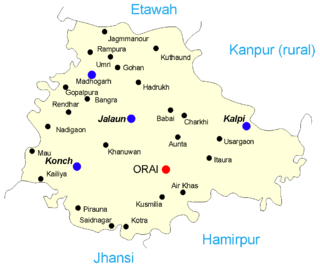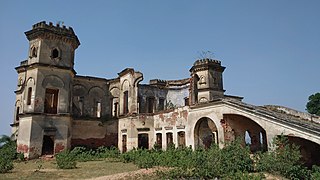
Bundelkhand is a geographical and cultural region and a proposed state and also a mountain range in central & North India. The hilly region is now divided between the states of Uttar Pradesh and Madhya Pradesh, with the larger portion lying in the latter state.

Sonbhadra or Sonanchal is the second largest district by area of Uttar Pradesh after Lakhimpur Kheri. The district headquarters is in the town of Robertsganj. Sonbhadra is also known as the "Energy Capital of India" because there are multiple power plants.

Jalaun is a city and a municipal board in Jalaun district in the Indian state of Uttar Pradesh.

Jamui is a district among 38 districts of Bihar state, India. The district was formed on 21 February 1991, when it was separated from Munger district. It is located at a longitude of 86° 13'E and the latitude is 24° 55'N.

Hamirpur district is one of the 75 districts of Uttar Pradesh state of India and Hamirpur town is the district headquarters. Hamirpur district is a part of Chitrakoot Division. The district occupies an area of 4,121.9 km². The district has a population of 1,104,285. As of 2011 it is the third least populous district of Uttar Pradesh, after Mahoba and Chitrakoot. Two major rivers Yamuna and Betwa meet here. On the banks of river Betwa lies the "Coarse sand" which is exported to many parts in U.P.

Mahoba district is one of the districts of Uttar Pradesh state of India and Mahoba city is the district headquarters. Mahoba district is a part of Chitrakoot Division. The district occupies an area of 2884 km². It has a population of 875,958. As of 2011 it is the least populous district of Uttar Pradesh. Mahoba District is also known as Alha-Udal Nagari.
Satna is a city in the Indian state of Madhya Pradesh. It serves as the headquarters of Satna district. It is 7th largest city and 8th most populous city of the state. The city is 500 km east of the state capital Bhopal. The city is distributed over a land area of 111.9 square kilometres.

Jhansi district is one of the districts of Uttar Pradesh state in northern India. The city of Jhansi is the district headquarters. The district is bordered on the north by Jalaun District, to the east by Hamirpur and Mahoba districts, to the south by Tikamgarh District of Madhya Pradesh state, to the southwest by Lalitpur District, which is joined to Jhansi District by a narrow corridor, and on the east by the Datia and Bhind districts of Madhya Pradesh. Population 19,98,603. Lalitpur District, which extends into the hill country to the south, was added to Jhansi District in 1891, and made a separate district again in 1974.
Charkhari is a city in Mahoba district in the state of Uttar Pradesh, India. This is the Kashmir of Bundelkhand. It was the capital of the Charkhari concession. There are lakes named Vijay Sagar, Malkhan Sagar, Vanshi Sagar, Jai Sagar, Ratan Sagar and Kothi Tal. There are 108 temples of Krishna giving the nature and beauty of Vraj to Charkhari city. In which Gopal Bihari temple of Sudamapuri, Guman Bihari of Ryanpur, temple of Mangalgarh, Bakht Bihari, temple of Banke Bihari and cave of Madavya Rishi are there. It is also the headquarters of Charkhari Tehsil and the name of Legislative Assembly seat is also Charkhari. Legislative Assembly constituency.
Hamirpur is a town and a municipal board in Hamirpur district in the Indian state of Uttar Pradesh. Located just above the confluence of the Yamuna and Betwa rivers, it is the administrative headquarters of Hamirpur district.
Mauranipur is a town and a municipal board in Jhansi district state of Uttar Pradesh, India. It is located in the Jhansi District. It is the largest tehsils in India by land area. This town was known for textile production, known in ancient times as Madhupuri. Because of its high density of temples, it is known by some locals as Mini-Ayoddhya. Jalvihar Mela and Viman Yatra are the most famous events in Mauranipur. The Kedareshwar temple and the Saprar Dam are located near Mauranipur.

Kulpahar is a city in Mahoba district in the Indian state of Uttar Pradesh. It is a historical town in the Bundelkhand region. Before 11 Feb 1995 Kulpahar was a Tehsil of Hamirpur District. On 11 Feb 1995 Mahoba District was carved out of Hamirpur, and Kulpahar is now a part of the Mahoba District. Kulpahar is the largest Subdivision of Uttar Pradesh. Kulpahar is known for its closeness to Khajuraho and other historic places like Mahoba, Charkhari, Kalinjar Rath, Orchha, and Jhansi. This town holds relics of temples and man-made water bodies of the Chandela Dynasty
Kabrai is a city and a Nagar Panchayat, And a combination of 5 villages. POORANCHANDRA KUSWAHA is chairman of Kabrai nagar panchayat in Mahoba district in the Indian state of Uttar Pradesh in Bundelkhand Region. Kabrai is a City where stone mining is leading business. It is also known as stone city of uttar pradesh. There are around 350 stone crushers in and around the town. Most of city's revenue comes from mining. Due to this, place also has mining mafias. Kabrai is known for major business firms some of the name includes, Siddh Gopal Sahu,kamlesh soni ,Dheerendra pratap singh, Jaywant Singh Ankit Tripathi, Mahesh Tiwari,Bapu g gurudev BIP, A.K. Tripathi, Sankar Pratap Tiwari. Kabrai is situated between Banda and Mahoba and well connected by NH 86 and NH 76 Kanpur Kabrai Road. Kabrai has a well known temple by the name of Kalshaha Baba, panch pahadi behind the name there us story that one a person was trekking on hill and there was Kalash filled with gold rolling towards him and told him to collect it and also do some good work for poor people from that day temple name is called Kalshah Baba. Kabrai is well also Connected with Railway Network. One can board trains from Kabrai Railway Station.
Kachhwa is a town and a nagar panchayat in Mirzapur district in the Indian state of Uttar Pradesh.
Naraini is a town and Nagar panchayat in Banda district in the Indian state of Uttar Pradesh. It is one of the four tehsils of Banda District.

Chitrakoot district is one of the districts of Uttar Pradesh state of India in the Bundelkhand region and Chitrakoot city is the district headquarters. Chitrakoot district is a part of Chitrakoot Division. The district occupies an area of 3,216 km².The district has a population of 991,730. As of 2011 it is the second least populated district of Uttar Pradesh, after Mahoba.

Rajnagar is a town and nagar panchayat in Chhatarpur district in the Indian state of Madhya Pradesh, it is 6 km from Khajuraho, 5 km from Khajwa town and 35 km from district headquarters, Chhatarpur.
The demographics of Uttar Pradesh is a complex topic, which is undergoing dynamic change. Uttar Pradesh is India's most populous state, and the largest subdivision in the world. It has a population of about 199,812,341 as per the 2011 census. If it were a separate country, Uttar Pradesh would be the world's fifth most populous nation, next only to China, India, the United States of America and Indonesia. Uttar Pradesh has a population more than that of Pakistan. There is an average population density of 828 persons per km² i.e. 2,146 per sq mi. The capital of Uttar Pradesh is Lucknow, and Prayagraj serves as the state’s judicial capital. Hindus and Muslims both consider the state as a holy place.

Khajuraho is a city, near Chhatarpur in Chhatarpur district of the Indian state of Madhya Pradesh. One of the most popular tourist destinations in India, Khajuraho has the country's largest group of medieval Hindu and Jain temples, famous for their erotic sculptures. The Khajuraho Group of Monuments has been listed as a UNESCO World Heritage Site since 1986 and is considered one of the "seven wonders" of India. The town's name, anciently "Kharjuravahaka", is derived from the Sanskrit word kharjur meaning "date palm".
Chandel or Chandela is a Rajput clan from India. Families belonging to this clan ruled several kingdoms in north India and held various feudal estates. The most notable of these were the Chandelas of Jejakabhukti, who ruled the Bundelkhand region.












